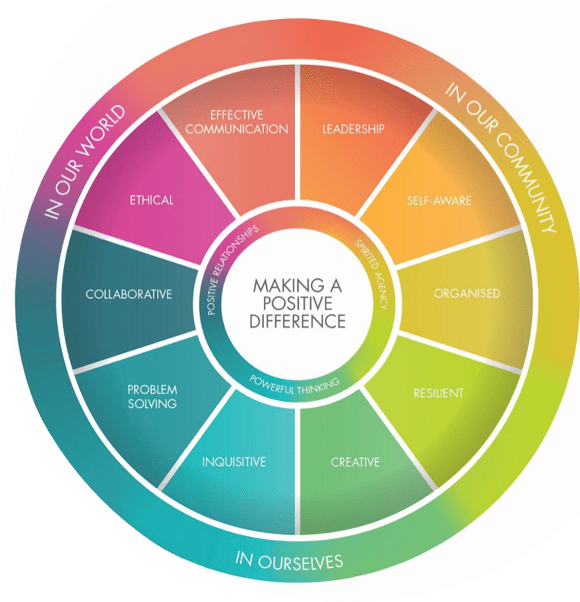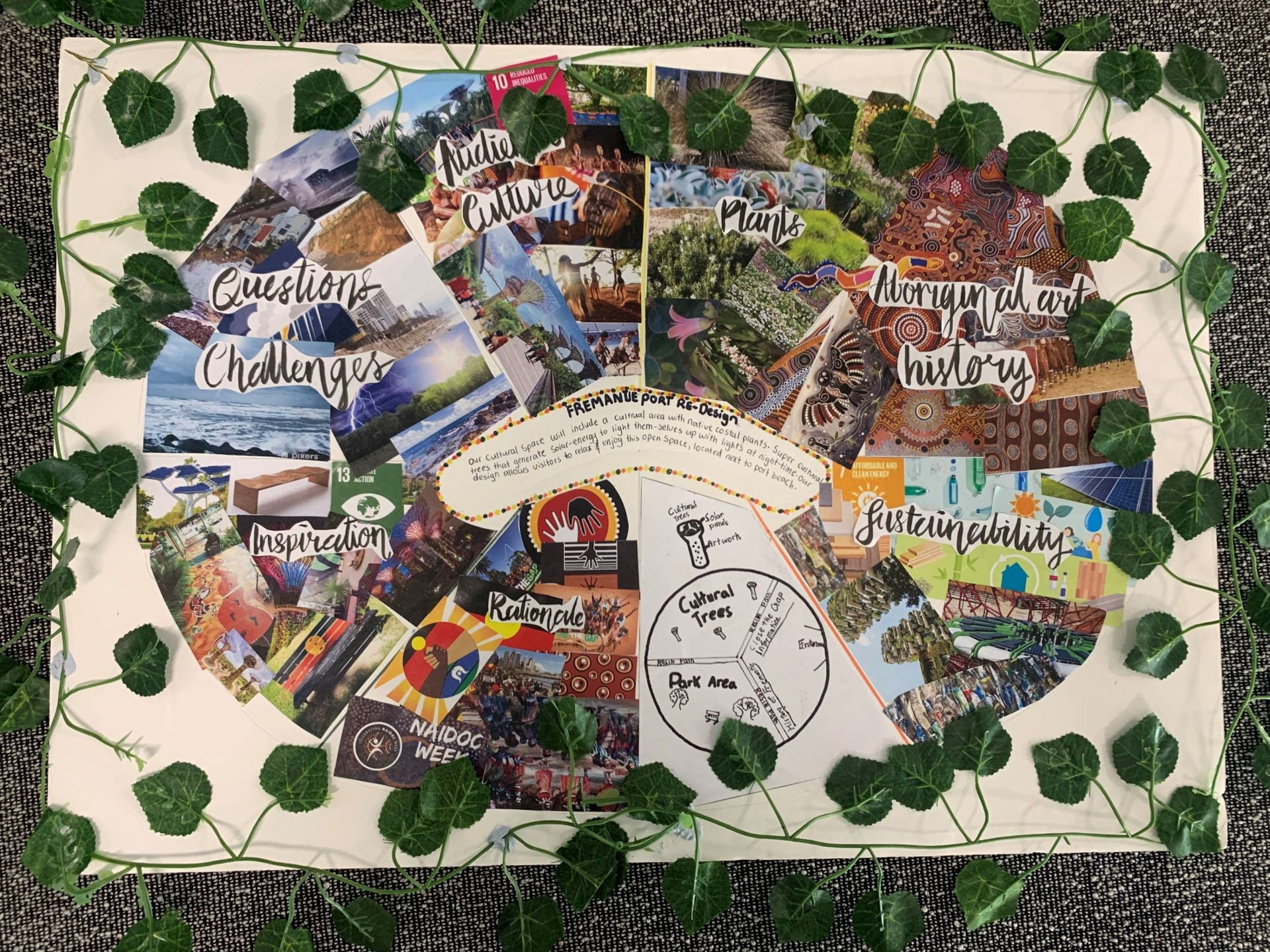
Utopia means an imagined place or state of things in which are perfect. This is what we are aiming for in this project, a perfect place.
Throughout Term 3, we worked in small groups of 4 to redesign our chosen area in Fremantle Port. This project had one main question- “How might we redesign Fremantle into a community where all people thrive?”. In English, we were introduced to the idea of a utopian community from reading the novel “The Giver”. In geography, we learned about liveability and sustainability. Mrs Lockwood, whose career focuses on infrastructure and redevelopment, gave us this opportunity to get our perspective and ideas of recreating the Fremantle Port region. This meant that our ideas could be used later in the future to create an area on Fremantle Port where all people thrive. I worked with Ariana, Jake and Stephanie and together we brought up an idea of a cultural green space. This project gave us an opportunity to learn and use the ASC Capabilities.

ASC Capabilites
The ASC Capabilities played a huge part in this project. There were 10 skills we need to try and use throughout Project Utopia. The school encouraged us to try and develop by the end of high school as it would help with our future to make a positive difference and integrate hobbies.

One of the main capabilities we developed and used since the start was effective communication. We learned by communicating effectively, we could prevent and help resolve our challenges. For instance, when we were creating our finalized idea, we all wanted to add more features that could benefit our draft. But it was impossible to apply all of the features. For example, if we wanted to install all the lights and plants, it would be too expensive and not sustainable. To solve this, we learned to listen to each other and negotiated the best solution to drive us on the right path. We also learned compromising was important to achieve a group decision. Even towards the upcoming showcase, we managed to always communicate and discuss either in person or on teams. Effective communication helped us improve our productivity as well as provided us with clarity and direction.
Organisation was something we knew would benefit our project. With the end in mind, we made sure we were staying organised. Not only did we keep our workspace and papers tidy, but we were also organised on what we needed to do every day. On the week of the showcase, we made a weekly plan on what we needed to do each day to ensure we were prepared and not fallen behind. For example, on a scheduled day, Steph and Ariana focused on the vision board while Jake and I were editing and completing our speech. By doing this, we were more time-efficient, and we didn’t leave an important part aside while focusing on another.
One capability we struggled with was collaboration. Although we stayed organized, problem solved, and communicated effectively, we found it was hard to collaborate all the time. Sometimes we worked in silence. This quickly was resolved as we built strategies to prevent them from happening regularly. We always talked and took on different parts to focus on, e.g. while researching we focused on different topics. This then naturally led us to become more collaborative to produce more efficient work.
We knew what capabilities we used each lesson as after each InnovatedED session, we would write our self-reflection on how well we did on our capabilities and ways we could improve on them. After writing all of the reflections, we planned for the next session how we would input our improvements on developing those needed capabilities.

UN Global Goals
The UN Global Goals are 17 goals the UN established to encourage action to protect our planet. These goals are aimed to be achieved by 2030. Our group mainly focused on reduced inequalities (goal 10), affordable and clean energy (goal 7) and climate action (goal 13). We then knew by including these chosen goals, our in-fill development would be much more liveable and sustainable.
Sustainablity
Sustainability is the idea that humans must interact with the environment in a way that ensures there will be enough resources left for future generations. Something unique we had in our redesign was cultural trees. This was where most of our focus was, to ensure it was sustainable. We researched the most sustainable materials and paint. The cultural trees idea did run into problems. A couple of examples were: “wouldn’t trees producing its light be too expensive?”; “can it produce light with energy that is clean and sustainable?”. We took action and researched ways to produce clean and affordable energy. The solution was for our trees to produce their energy by using solar panels. I learnt that focusing on one particular feature for a period of time can improve productivity and engage us to work together. We could get much more work done and problem solve immediately rather than leaving it behind. I was glad we focused on one thing then the next, otherwise, we would be in a total mess. I also learnt sustainability was vital, especially because our resources were slowly running out.
Liveability

In HASS (geography), we were learning about liveability which we needed to include in our project. Liveability is the level of how pleasurable (liveable) a place is and includes many human needs such as food, security, arts and culture, diversity, and a sense of place. Our group focused on arts and culture as well as increasing social liveability. As I was researching, I came across a national campaign called ‘Close The Gap’. It is a campaign that aims to close the gap of inequality between the non-indigenous and the indigenous people. That then gave me an idea to add this campaign as the rationale for our project. Because of this, we added more indigenous features (pathways, artwork). Our design aimed to improve the liveability of the indigenous people. I learnt researching benefits the result. Without research, you may never find a unique idea that would separate your group project from others.

Our vision board includes images and projects our idea visually. 
My group at the utopia showcase
Public Speaking
In English, we completed an assessment that would help our showcasing skills. The assessment was to present a 4-minute oral presentation (and present it to the class) about what we were going to say at the Project Utopia showcase. We needed to include an introduction, liveability, sustainability and the global goals, and a conclusion. I focused on the liveability of our redesign. Each group wrote and rehearsed their speech. The presentations were done during class time, where our teacher recorded us. I think I did decently well as I always loved public speaking. My teacher said I presented with such joy and I am proud of that. I learnt from this that I need to improve on my pace as in some parts I did rush. As a group, we were given feedback on our speech itself, where we needed to include more information in various parts.
When it came to the showcase, my group presented 5-6 times to the interested parents and special guests. The showcase invited all of our parents/relatives to come to listen to our speech and ask questions. I liked how this showcase bought out some laughs and bought our group together. The showcasing taught me by answering questions and listening to feedback, my knowledge expands and I can improve with the help of others.

Project Utopia has taught me many new things. It allowed me to learn and hear from experts. This project helped me learn more about myself and others, I realised how sharing ideas and communicating is so important in group projects. I liked how this project was unique and had a real-life purpose. I also developed useful skills from this project like using time wisely, keeping organised and solving challenges. These skills will definitely help me in the future.


– 2021